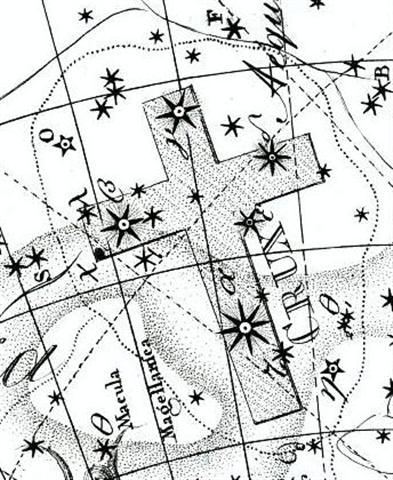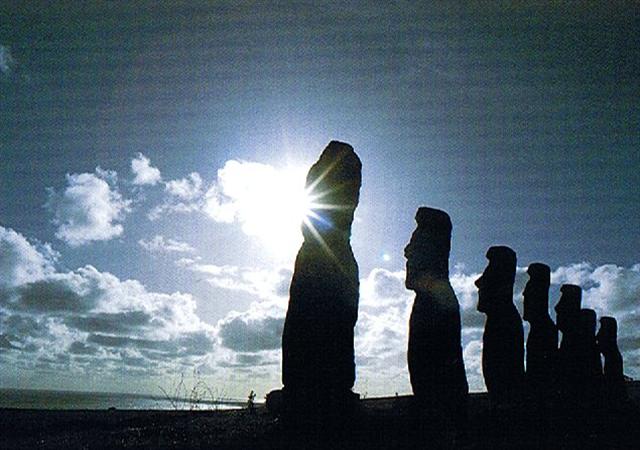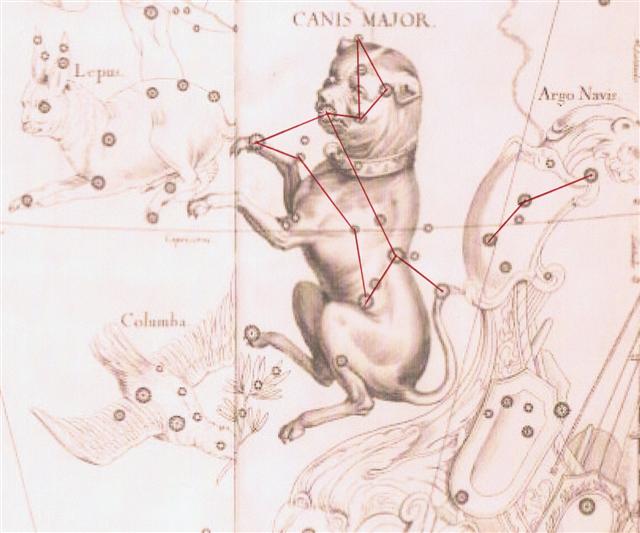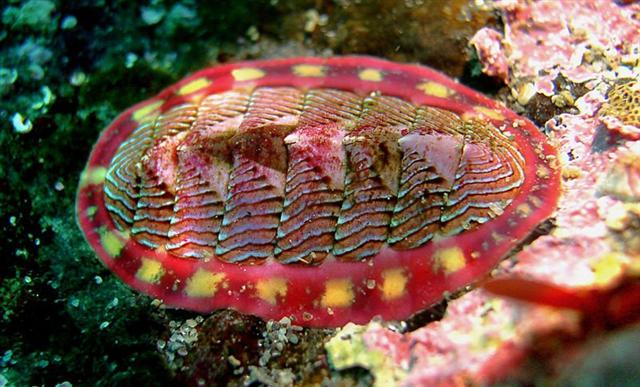The figure depicted in Gb3-15 is of the type which I have named Rogo:
|
JAN 16 (*301) |
17 |
18 |
19 (314 + 70) |
20 |
21 |
 |
 |
 |
 |
 |
 |
|
Gb3-11 (301) |
Gb3-12 |
Gb3-13 |
Gb3-14 (75) |
Gb3-15 |
Gb3-16 |
|
Al Fargh al Thāni-25
(Rear Spout)

0h (365.25)
CAPH (Hand) =
β
Cassiopeiae, SIRRAH
(Navel of the Horse) =
α
Andromedae
(0.5),
ε
Phoenicis,
γ³
Oct.
(0.8) |
Uttara Bhādrapadā-27
(2nd of the Blessed
Feet) /
Wall-14 (Porcupine)
ο Oct. (1.3),
ALGENIB PEGASI = γ
Pegasi
(1.8) |
χ Pegasi (2.1), θ
Andromedae (2.7) |
σ Andromedae (3.0), ι
Ceti (3.3), ζ Tucanae
(3.5), ρ Andromedae, π
Tucanae (3.7) |
Julian equinox
No star listed (4) |
ANKAA =
α
Phoenicis,
κ
Phoenicis (5.0)
ALPHARD (α Hydrae) |
|
March 21 (0h) |
22 |
23 |
24 |
3-25 (84) |
26 (450) |
|
°March 17 |
18 |
19 |
20 |
0h |
22 (81) |
|
'Febr 22 (53) |
Terminalia |
24 |
25
(*341) |
26 (422) |
27 (58) |
|
"Febr 8 |
9 (*325) |
10 |
11 |
12 (408) |
13 (44) |
|
CLOSE TO THE FULL MOON: |
|
JULY 17 (*118) |
18 |
19 (200) |
20 |
21 |
22-7 |
|
12h (182.6)
ο
Virginis (182.1),
η
Crucis (182.5) |
ALCHITA =
α
Corvi, MA WEI (Tail of
the Horse) =
δ
Centauri
(183.1),
MINKAR =
ε
Corvi
(183.7),
ρ
Centauri (183.9) |
PÁLIDA (Pale) =
δ
Crucis
(184.6),
MEGREZ (Root of the
Tail) =
δ
Ursae Majoris
(184.9) |
Hasta-13 (Hand) /
Chariot-28 (Worm)
GIENAH (Wing) =
γ
Corvi
(185.1),
ε
Muscae (185.2),
ζ
Crucis (185.4),
ZANIAH (Corner) =
η
Virginis
(185.9)
*144.0 = *185.4 - *41.4 |
CHANG SHA (Long
Sand-bank) =
ζ
Corvi
(186.3) |
INTROMETIDA (Inserted) =
ε
Crucis (187.4), ACRUX =
α
Crucis
(187.5)
*146.0 = *187.4 - *41.4 |
|
Sept 19 |
20 |
21 |
EQUINOX |
23 (266) |
24 (*187) |
|
°Sept 15 |
16 |
17 |
18
(261) |
19 |
20 (*183) |
|
'Aug 23 |
24 (236) |
25 |
26 |
27 |
28 (*160) |
|
"Aug 9 |
10 (222) |
11 |
12 |
13 |
14 (*146) |

...
Crux lies in the Milky
Way, - here a brilliant
but narrow stream three
or four degrees wide, -
and is noticeable from
its compression as well
as its form, being only
6º in extent from north
to south, and less in
width, the upper star a
clear orange in color,
and the rest white; the
general effect being
that of a badly made
kite, rather than a
cross ...
...
Whittier said, in his
Cry of a Lost Soul:
'The Cross of pardon
lights the tropic
skies'; which is correct
for our day, as it is
not now entirely visible
above 27º 30' of north
latitude. It was last
seen on the horizon of
Jerusalem - 31º 46' 45''
- about the time that
Christ was crucified.
But 3000 years
previously all its stars
were 7º above the
horizon of the savages
along the shores of the
Baltic Sea, in latitude
52º 30' ...
Von
Humboldt adds: The two
great stars, which marks
the summit and the foot
of the Cross, having
nearly the same right
ascension, it follows
that the constellation
is almost perpendicular
at the moment when it
passes the meridian.
This circumstance is
known to the people of
every nation situated
beyond the Tropics or in
the southern hemisphere.
It
has been observed at
what hour of the night,
in different seasons,
the Cross is erect or
inclined.
It is
a time piece, which
advances very regularly
nearly four minutes a
day, and no other group
of stars affords to the
naked eye an observation
of time so easily made.
How often have we heard
our guides exclaim in
the savannahs of
Venezuela and in the
desert extending from
Lima to Truxillo,
'Midnight is past, the
Cross begins to bend'
... |
South of the equator spring
equinox was 265 - 80 = 185 days
after the autumn equinox. North of
the equator spring equinox was
365 - 185 = 180 days after
the autumn equinox:
|
Gregorian equinox |
63 |
1 |
229 |
75 |
Julian equinox |
|
 |
 |
|
Gb6-26 (408) |
Gb3-15 (305) |
|
March 21 (80) |
368 = 365 + 3 |
March 25 (84) |
|
...
When Julius Caesar
established his calendar
in 45 BC he set March 25
as the spring equinox.
Since a Julian year
(365.25 days) is
slightly longer than an
actual year the calendar
drifted with respect to
the equinox, such that
the equinox was
occurring on about 21
March in AD 300 and by
AD 1500 it had reached
11 March. This drift
induced Pope Gregory
XIII to create a modern
Gregorian calendar. The
Pope wanted to restore
the edicts concerning
the date of Easter of
the Council of Nicaea of
AD 325 [3 * 25 = 75
→ Gb3-14 → Gb3-11 → 11
March]. |
It seems probable that Rogo
in Gb3-15 was intended to illustrate
the Full Moon at the position 'south
of the equator', down where the
fishes were. The central bird with a
high neck standing at the corner
(Zaniah) no longer had an eye - his
mana had fled.
... There is
a curious tradition concerning
these grizzled, otherworldly
statues, solemn and powerful,
with their blank, aloof
eye-sockets gazing out over the
limitless ocean. Like most of
the other Moai of Easter
Island the local belief is that
they died, long ago, at the time
when mana - magic -
supposedly fled from the island
never to return. However, in
common with only a very few of
the other Moai, it is
believed that these particular
statues still have the power,
twice a year, to transform
themselves into aringa
ora - literally 'living
faces' - a concept startingly
similar to the ancient Egyptian
notion that statues became
'living images' (sheshep ankh)
after undergoing the ceremony of
the 'opening of the mouth and
the eyes'. Statues at Angkor
were likewise considered to be
lifeless until their eyes had
been symbolically 'opened'
...

Therefore, in the C text the
position of Rogo in
Ca3-25 presumably alluded to
March 25 and the Julian equinox:
|
tagata tuu rima ki
ruga |
te maitaki |
te henua |
Rei hata ia |
tagata rogo |
 |
 |
 |
 |
 |
|
Ca3-21
→ March 21 |
Ca3-22 (73) |
Ca3-23 |
Ca3-24 |
Ca3-25
→ March 25 |
|
Rogo.
Rogorogo:
Originally, 'orators,
bards' of Mangareva.
Borrowed into the
Rapanui language in
1871, it came to
generically signify the
wooden tablets incised
with glyphs, the writing
system itself, and the
respective inscriptions.
Earlier the term ta
was used for the
writings. Fischer. Mgv.:
rogouru, ten.
Mq.: onohuu,
okohuu, id.
Churchill. |
|
CLOSE TO THE FULL MOON: |
|
π4
Orionis (72.1),
ο¹ Orionis (72.4),
π5
Orionis (72.8)
*31.0 = *72.4 - *41.4 |
π¹
Orionis (73.0),
ο² Orionis (73.4),
HASSALEH = ι Aurigae
(73.6),
π6
Orionis (73.9)
*32.0 = *73.4 - *41.4 |
ALMAAZ (The Male Goat) =
ε
Aurigae
(74.7),
HAEDUS I = ζ Aurigae
(74.8) |
HAEDUS II = η Aurigae
(75.9) |
5h (*76.1)
ε
Leporis (76.0),
CURSA (Footstool) = β
Eridani (76.4),
λ
Eridani (76.7)
*35.0 = *76.4 - *41.4 |
|
June 1 (152) |
2 (336 - 183 = 153) |
3 |
4 |
5 |
|
"April 21 (111) |
22 |
23 |
24 |
25
→ 4-25 |
 |
|
CLOSE TO THE SUN: |
|
Dec 1 |
2 (336) |
3 |
4 |
5 |
|
ºNov 27 |
28 (332 = 322 + 10) |
29 |
30 |
ºDec 1 (335) |
|
ι Ophiuchi (255.3),
GRAFIAS = ζ Scorpii
(255.4)
*214.0 = *255.4 - *41.4 |
κ Ophiuchi (256.2), ζ
Arae (256.5), ε Arae
(256.8),
CUJAM (Club) = ε Herculi
(256.9) |
No
star listed (257) |
17h (*258.7)
ARRAKIS = μ Draconis
(258.7) |
Mula-19 (The Root)
SABIK (The Preceding
One) =
η
Ophiuchi
(259.7),
η
Scorpii (259.9) |
However, his position was not
spring equinox but 5h,
presumably because the beginning
of the Rigel year was just
around the corner.
... Raven
began to search for the girls.
For it is the way of things in
the world that there are both
males and females of every
creature. Somewhere there must
be girls. Raven searched and
searched. Under logs and behind
rocks, he looked. But he could
not find the hiding place of the
first girls.
Adara (Virgins, ε
Canis Majoris, at his belly)
rose heliacally in July 3
(*104).

But as he
searched, the tide was going
out, and as it reached its
lowest, the Raven spotted some
giant Chitons clinging to the
rocks. These giant shell fish
had but one shell, fastened
tightly to the rocks with huge
soft lips around their edges.
Raven pried one loose with his
beak. And there inside was a
girl. He pried off another, and
another, and another in each was
a girl. They were very similar
to the creatures he had found in
the clamshell, but more like the
Chiton, softer and rounder, in
contrast to the hard shell and
strong muscles of the clam. And
these were just as frightened of
the Raven. He gathered them onto
his back with difficulty, and
brought them to the boys he had
found in the clamshell ...

|












